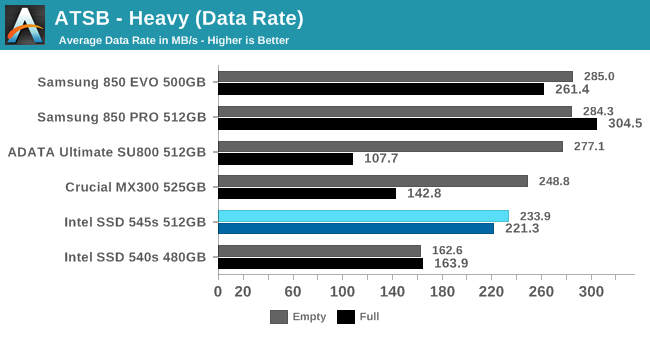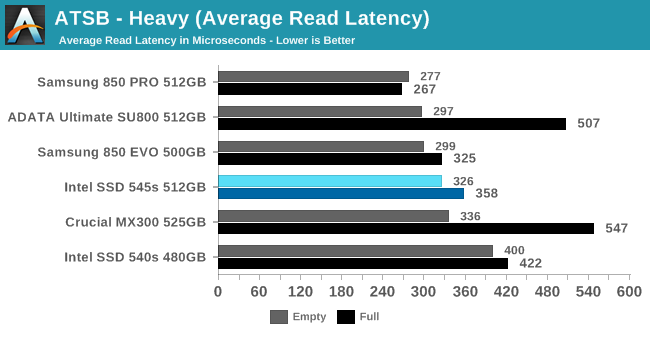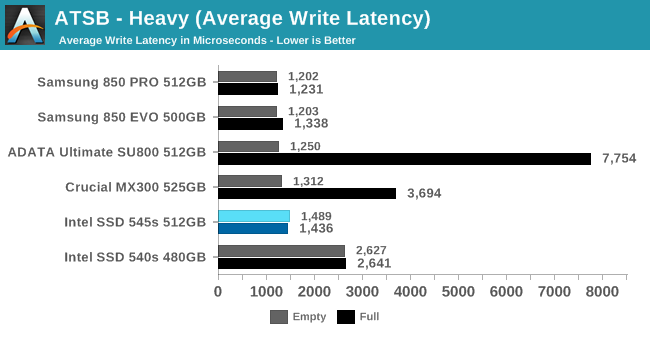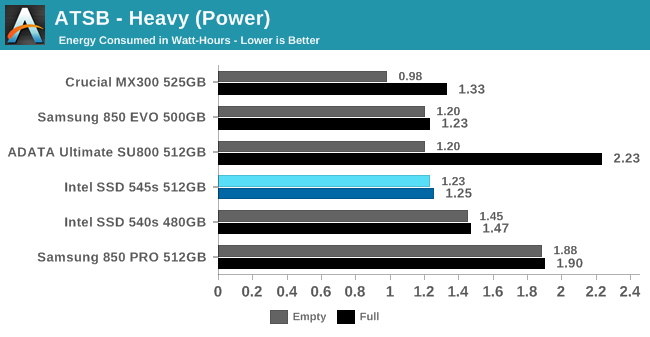The Intel SSD 545s (512GB) Review: 64-Layer 3D TLC NAND Hits Retail
by Billy Tallis on June 27, 2017 6:00 AM ESTAnandTech Storage Bench - Heavy
Our Heavy storage benchmark is proportionally more write-heavy than The Destroyer, but much shorter overall. The total writes in the Heavy test aren't enough to fill the drive, so performance never drops down to steady state. This test is far more representative of a power user's day to day usage, and is heavily influenced by the drive's peak performance. The Heavy workload test details can be found here. This test is run twice, once on a freshly erased drive and once after filling the drive with sequential writes.

The Intel SSD 545s shows substantial improvement over the 540s in average data rates for the Heavy test. The 545s is not quite able to compete against Samsung as was the case for The Destroyer, but it comes much closer than its predecessor.
The 545s also fares far better when the test is run on a full drive than the drives that use the previous generation 32L 3D TLC (ADATA's SU800 and Crucial's MX300). Both of those drives beat the 545s when the test is run on an empty drive, but suffer a huge performance loss when the drive is full.

The latency measurements for the Intel 545s on the Heavy test tell a similar story to the average data rates. Intel is now in the same league as the other 3D NAND SSD, though still in last place. When the test is run on a full drive, the Crucial and ADATA drives fall apart and average latency spikes to the 2–4ms range while the latency of the Intel 545s is unaffected and remains well below 1ms.


The read latency of the older Intel 540s is not too far behind the 3D NAND drives and it handles being full with no trouble, but its write latency in either case is almost twice as high as the 3D NAND drives. The biggest improvement of the Intel 545s comes from cutting that write latency. The read latency also improved enough to surpass the Crucial MX300.

The energy usage of the Intel 545s during the Heavy test has it essentially tied for second place with the Samsung 850 EVO, while the Crucial MX300 has the clear lead when the test is run on an empty drive. The MX300's advantage disappears when the test is run on a full drive and the SU800's energy usage almost doubles.










74 Comments
View All Comments
ddriver - Tuesday, June 27, 2017 - link
Actually yes. Way to go intel...anactoraaron - Tuesday, June 27, 2017 - link
What's wrong with the 600p? You can get the 512gb from newegg for $179, which make me question the 545s price point. If you aren't limited to sata, the 600p 512gb makes much more sense.ddriver - Tuesday, June 27, 2017 - link
"What's wrong with the 600p? "Nothing, aside from the fact it is THE lousiest NVME SSD in the known universe...
Drumsticks - Tuesday, June 27, 2017 - link
Good thing it generally sells at SATA prices then...junky77 - Wednesday, June 28, 2017 - link
It's really not even as fast as SATA SSDs in many tests (I'm talking midrange SSDs, nothing fancy)kaidenshi - Wednesday, June 28, 2017 - link
I've seen a ton of hate for the 600p here, and I can only conclude that I got extremely lucky with mine and ended up with a fluke. Mine has been hands down the fastest SSD I've ever had, and even paired with a bargain-basement Pentium G4500 CPU, it makes everything on my PC feel instant.Perhaps it is the slowest NVMe SSD one can buy, but it is much, much faster than any SATA SSD I've had in this machine. It definitely blows the doors off the 850 Evo, despite claims I've seen here that it's slower. The results on this site mirror what I've seen in my own testing. Basically, the Samsung beats the Intel on random reads only, but loses spectacularly on all other metrics.
http://ssd.userbenchmark.com/Compare/Samsung-850-E...
Samus - Thursday, June 29, 2017 - link
It isn't a speed demon, but it isn't slow either. It's just what you'd expect for the price.And it's sequential transfer rates are substantially faster than anything SATA, so that is the icing on the cake for an SSD that sells for SATA prices.
And being Intel, I expect it will be ultimately more reliable than a similar priced product form ADATA, etc.
alpha754293 - Thursday, June 29, 2017 - link
What's wrong with the Intel 750 series PCIe NVMe SSDs?futrtrubl - Tuesday, June 27, 2017 - link
I'm going to assume the sustained sequential write speed of 40MB/s is a typo.futrtrubl - Tuesday, June 27, 2017 - link
Oh wow, I see it is not.